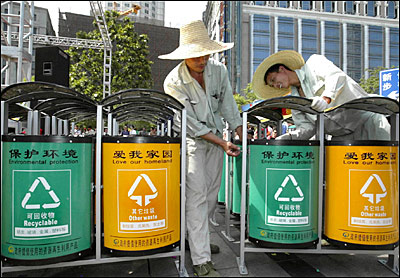| Green strategy
|
|
Environmental protection has been a basic national policy since the
1980s. The State Environmental Protection Committee was established in
1984 and the first Environmental Protection Law formally issued in 1989.
After the United Nations Conference on Environment and Development in
1992, China was one of the first countries to formulate and carry out a
strategy of sustainable development. In 1993, the Environmental
Resources Committee of the NPC was set up. So far, the state has
promulgated eight laws for environmental protection, 14 laws for
management of natural resources and 35 regulations on environmental
protection. Environmental protection authorities have publicized over
100 national environmental protection regulations and more than 1,000
local ones.
Responding to stresses on natural resources caused by fast economic
growth, development and urbanization, the state at the turn of the 21st
century responded with a "green strategy" that includes developing a
revolving economy, increasing resource-use efficiency; developing clean
production, reducing pollution cost in production processes; developing
green consumption, reducing ecological impact of consumption; developing
new energy resources, reforming production methods, moving toward
ecological industrial civilization, and creating a balanced ecological
environment.
Environmental protection is changing from the down-stream,
after-the-event management of the past to today's whole-process
supervision and control. The Cleaner Production Promotion Law and the
Environment Impact Assessment Law, which went into effect on January 1
and September 1, 2003 respectively, provide guarantees to implement this
strategy. The former requires full control over all the production
links -- from production design, choice of energy resources and raw
materials, technology, equipment maintenance, to waste recycling -- so
as to reduce pollution and promote resource recycling. The latter
requires all authorities at city level and above to make environmental
impact assessments when making plans for land use, construction and
development of districts, river basins and sea areas. In October 2002
the State Environmental Protection Administration authorized the
presence of specialized personnel at the 13 key national projects to
assess and control their environmental impact. These projects included
the laying of railroad lines in Qinghai Province and Tibet and the
laying of pipeline transporting natural gas from western China to the
eastern coastal areas.

|
|
|
|
|
|
 |
|
|

No comments:
Post a Comment